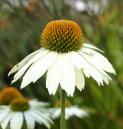 The dried bark of the rhizome of Ru'bus villo'sus Aiton, Rubus Nigrobaccus, Bailey, and Rubus cuneifolius Pursh.
The dried bark of the rhizome of Ru'bus villo'sus Aiton, Rubus Nigrobaccus, Bailey, and Rubus cuneifolius Pursh.
 DESCRIPTION OF DRUG.—In thin, tough, pliable bands 1 to 2 mm. (1/25 to 1/12 in.) thick, having a blackish-gray outer surface, longitudinally wrinkled, and a pale brown inner. surface; bast layers tangential, the fibers easily removed. Odorless; taste astringent and somewhat bitter. The root of Rubus canadensis Linné (dewberry) very closely resembles that of blackberry in medical properties.
DESCRIPTION OF DRUG.—In thin, tough, pliable bands 1 to 2 mm. (1/25 to 1/12 in.) thick, having a blackish-gray outer surface, longitudinally wrinkled, and a pale brown inner. surface; bast layers tangential, the fibers easily removed. Odorless; taste astringent and somewhat bitter. The root of Rubus canadensis Linné (dewberry) very closely resembles that of blackberry in medical properties.
Powder.—Light brown. Characteristic elements: Parenchyma of cortex, thin walled, with starch, spherical (3 to 7 µ in diam.), thick, porous, elongated; bast fibers, walls of medium thickness, with some starch; wood fibers, ducts and tracheids, numerous with simple pores; cork considerable (20 to 30 µ in diam.); calcium oxalate crystals, aggregate (25 to 30 µ in diam.).
CONSTITUENTS.—The virtues of the bark depend chiefly upon the tannin present, about 10 to 15 per cent.
ACTION AND USES.—Tonic and astringent. From a popular domestic remedy it has come into extensive use in the treatment of diarrhea, dysentery, and relaxed conditions of the bowels generally. Dose: 15 to 30 gr. (1 to 2 Gm.).
PREPARATIONS: Fluidextractum Rubi, Syrupus Rubi, N.F.
RUBI FRUCTUS, N.F.—Includes two varieties of ripe fruits: Nigrobaccus and Villosus. A Syrup is recognized in the N.F.

